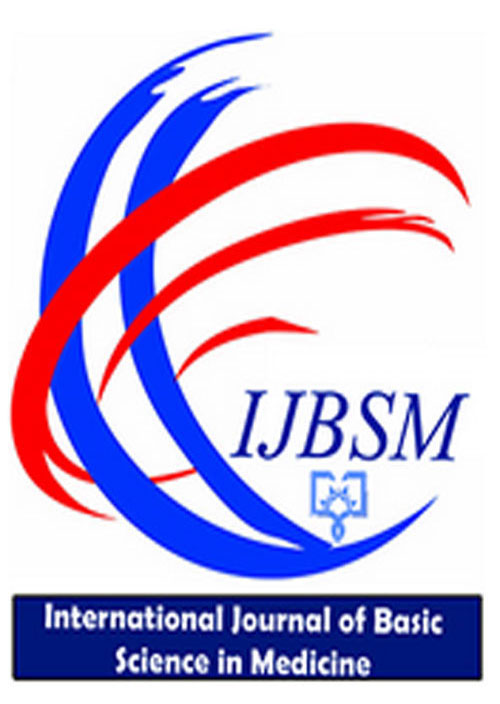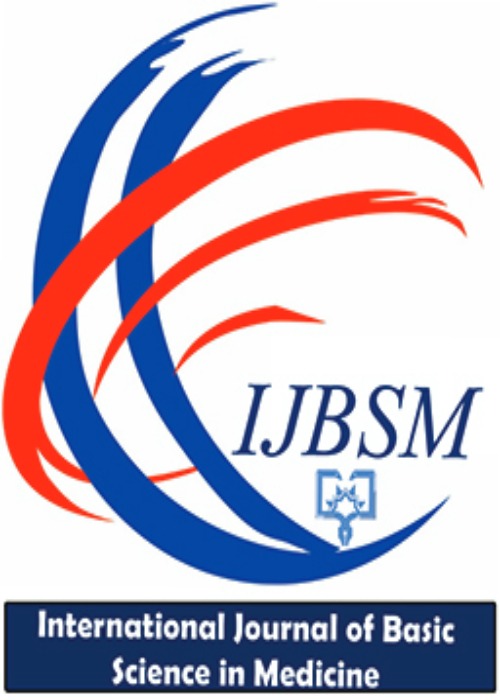فهرست مطالب

International journal of basic science in medicine
Volume:7 Issue: 2, Jun 2022
- تاریخ انتشار: 1401/07/30
- تعداد عناوین: 8
-
-
Pages 47-56
A genetically-identical bacterial population is phenotypically heterogeneous, with phenotypic variants arising due to fluctuations in gene expression. Persister formation may be induced by environmental factors/stress such as antibiotic treatment, signalling molecule indole, quorum sensing molecules, nutrient starvation, oxidative stress, heat stress, hyperosmotic stress, and acid stress. Since persisters are clinically relevant, it is important to study the mechanisms responsible for persister formation so that therapies can be designed to curtail these infections.
Keywords: Antibiotic, Persisters, Infection, Mechanisms, Medicine -
Pages 57-60Introduction
Blood-borne infections have always been concerns for the health system, as well as patients receiving blood products. In the present study, our aim was to determine the prevalence of hepatitis B (HBV) and C (HCV) virus infections in the blood units donated in Jiroft city, Kerman province, Iran, during a 5-year period (2011-2016). We also analyzed the demographic characteristics of donors.
MethodsThis was a cross-sectional study. Records available in the blood center of Jiroft was used as the source for collecting the data required (i.e., demographic features, results of laboratory tests, etc.). SPSS software version 22 was used to analyze the data using descriptive statistics (frequency and percentage). The chi-square test was used to identify any association between categorical variables at a significant level of P<0.05.
ResultsThe total number of blood donors was 36117. Hepatitis B and C frequencies were 3.3 and 0.44 per 1000, respectively. The highest infection rates were observed in 21-30-year-old donors. The prevalence of hepatitis B and C were higher among first-time, married, and male donors. Hepatitis B and C frequencies indicated a decreasing trend, reaching 2 and 0.4 per 1000 in 2016 from the initial 5.2 and 0.55 per 1000 in 2011, respectively. The results of the Chi-square statistical test showed that the difference in the number of people who had hepatitis in the period of 2011-2016 had a statistically significant decreasing trend (P<0.001).
ConclusionThe prevalence of hepatitis B and C infections in blood donors declined from 2011 to 2016. It is recommended to continue screening tests and educate donors to even lower blood-borne viral infections among Jiroft blood donors.
Keywords: Hepatitis B, Hepatitis C, Blood transfusion -
Pages 61-68Introduction
Prostate cancer is one of the most common diseases worldwide, and many efforts are made to treat this disease; however, these efforts seem to be futile. Accordingly, this study tends to compare the cytotoxic and oxidative (as shown by the production of reactive oxygen species (ROS)) effects of resveratrol in comparison with cisplatin in a prostate cancer cell line (LNCap).
MethodsAfter treatment of LNCap cells with the concentrations of 1, 10, 100, 500, and 1000 µg/mL of resveratrol, and 1, 5, 10, and 50 µg/mL of cisplatin, the viability percentage of cells was analyzed using MTT and spectrophotometry. Also, ROS production in this cell line at the IC50 concentrations of cisplatin and resveratrol was analyzed using flow cytometry.
ResultsThe results of the MTT test showed that cisplatin and resveratrol could both reduce cell viability at high concentrations because of increased cytotoxicity. Measurement of ROS production showed that cisplatin and resveratrol increased ROS levels compared to control cells.
ConclusionThe results obtained from this study showed that resveratrol, as a plant derivative, had anticancer and antioxidant properties against the LNCap prostate cancer cell line. Because of the side effects of cisplatin, it can be replaced by resveratrol as a good candidate to be used in chemotherapy.
Keywords: Prostate cancer, Resveratrol, Cisplatin, Reactive oxygen species -
Pages 69-76Introduction
COVID-19 pandemic has affected individual lives in several aspects, including physical activity and dietary pattern, which are common challenges among children with autism spectrum disorder (ASD). The purpose of this clinical trial was to investigate the effect of functional training along with online nutritional education on physical fitness indicators in 8-12 years old children with ASD.
MethodsEighty children with ASD (age=9.73±1.29 years, weight=49.94±2.08 kg, height=146.08±40 cm, BMI percentile=64.88±2.89, fat mass percentage=24.71±1.48) were randomly divided into four groups, including: (1) functional training, (2) online nutritional education, (3) functional training+nutritional education, and (4) control group. The interventional groups received their specific interventions for eight weeks and three session per week. The control group did not receive any intervention. Physical fitness indicators were assessed prior to the intervention and at the end of eight weeks.
ResultsThere was no significant difference between the demographic and physical fitness parameters (PFPs), including upper limb, lower limb, abdominal, trunk strength, cardiorespiratory fitness, dynamic and static balance, flexibility, speed, and 1 repetition-maximum (1RM) between the groups before the interventions (P ˃ 0.05). There was a significant improvement in physical fitness indicators in all the interventional groups in comparison with the control group (P≤0.001).
ConclusionThe results of this study indicated that functional training and online nutritional education may improve physical fitness indicators in ASD children, offering beneficial health outcomes during the COVID-19 pandemic.
Keywords: Autism spectrum disorder, COVID-19, Functional training, Online nutritionaleducation, Physical fitness -
Pages 77-81Introduction
5-Hydroxytryptamine (5HT) and kisspeptin are satiety factors, and ghrelin and adiponectin are orexigenic peptides. In this study, the mediating role of 5HT in the effects of GPR54 receptor blocking on ghrelin and adiponectin secretion was investigated.
MethodsMale Wistar rats weighing 220-250 g received saline, kisspeptin 10 (1 or 3 nmol), 5HT (2, 5 or 10 µg), kisspeptin plus 5HT, or peptide 234 (P234) plus 5HT via the third cerebral ventricle. Serum ghrelin and adiponectin concentrations were determined using the enzymelinked immunosorbent assay method.
ResultsKisspeptin or 5HT treatment significantly reduced serum concentrations of ghrelin and adiponectin in comparison with saline. The injection of 2 nmol of P234+5HT significantly reduced serum ghrelin concentration compared to the 5HT alone, kisspeptin alone, and kisspeptin+5HT groups. Injections of either 1 or 2 nmol of P234 along with 5HT significantly declined the mean serum adiponectin level compared to rats received the kisspeptin plus 5HT.
ConclusionKisspeptin/GPR54 signaling pathway may be a putative target in serotonergic neurons to control ghrelin and adiponectin secretion.
Keywords: 5-Hydroxytryptamine, Ghrelin, Adiponectin, Kisspeptin, Peptide 234 -
Pages 82-88Introduction
Obesity-related inflammation has an important role in increasing the risk of various pathological conditions, including insulin resistance. In this study, the effects of 8 weeks of moderate and high-intensity circuit resistance training on the levels of serum amyloid A (SAA) and insulin resistance were investigated in sedentary men.
MethodsIn this study, 36 sedentary men (average BMI: 30.64±3.14 kg/m2 , age of 20 to 35 years old) were randomly assigned to the control (C), moderate-intensity circuit resistance training (MRT), and high-intensity circuit resistance training (HRT) groups. The training protocol was performed during eight weeks (three sessions per week). Blood samples were collected before and after eight weeks of training, and serum levels of SAA, insulin, and glucose were measured. The data were analyzed by SPSS-24 software using the analysis of covariance (ANCOVA) test with the Bonferroni post hoc test.
ResultsThe present study’s findings indicated that SAA levels and insulin resistance significantly reduced in the HRT and MRT groups compared to the control group (P<0.001). However, our results showed that the changes observed in SAA and insulin resistance were not significantly different between the HRT and MRT groups (P>0.05).
ConclusionIt seems that HRT has no extra effects on inflammation and insulin resistance compared to MRT; however, changes in the levels of other inflammatory mediators should be determined
Keywords: Exercise training, Obesity, Insulin resistance, Inflammation -
Pages 89-93Introduction
Urinary tract infections (UTIs) are the most prevalent infections in patients worldwide. Escherichia coli is considered as the most prevalent etiological agent of UTIs. The prevalence of extended-spectrum beta-lactamase (ESBL)-producing isolates is a health care concern worldwide. The aims of this study was to determine antibiotic resistance profiles and the prevalence of the blaCTXM, blaSHV, and blaTEM genes in E. coli isolated from clinical samples obtained from patients with UTIs.
MethodsFrom September 2019 to March 2021, a total of 1200 urine samples were collected and analyzed from patients suspected of having UTI referred to Amir-Al-Momenin hospital of Zabol, Sistan and Baluchistan province, south-east of Iran. Antibiotic resistance patterns and the prevalence of the blaCTXM, blaSHV and blaTEM genes were determined using the disk diffusion method and PCR, respectively.
ResultsThe isolates were mostly resistance against ampicillin and trimethoprimsulfamethoxazole, with 66% and 54% of all isolates being resistant. Also, the isolates investigated were highly susceptible against meropenem and gentamycin (95%). The prevalence of the blaCTX, blaSHV, and blaTEM genes was 22%, 30%, and 24%, respectively.
ConclusionResistance against ampicillin and trimethoprim-sulfamethoxazole was high, therefore their prescription must be restricted. In addition, the expressions of the blaCTXM, blaSHV, and blaTEM genes were alarmingly high. In order to control the spread of infections by these isolates, constant monitoring of antibiotic resistance patterns is necessary
Keywords: E. coli, Extended-spectrum beta-lactamase, Urinary tract infection, Antibiotic resistance -
Pages 94-96Introduction
High-flow nasal cannula (HFNC) is an oxygen delivery procedure for patients with respiratory disorders. The role of this oxygen therapy system in the treatment of patients with COVID-19 has not been conclusively proven. The present study evaluated the efficacy and success of HFNC in improving the clinical condition of patients with COVID-19.
MethodsThe statistical population of this cross-sectional study was hypoxemic patients with the COVID-19 disease. The findings of the study were obtained by reviewing patients’ records and extracting information from the hospital information system.
ResultsA total of 29 patients with moderate to severe COVID-19 were analyzed. Comparison of the results of blood gas analysis of these patients showed that the use of HFNC did not make a significant difference in pH (P=0.063), PaCO2 (P=0.135), O2 sat (P=0.999), and HCO3 (P=0.717).
ConclusionOur study showed that the use of HFNC did not make a significant difference in respiratory parameters and the results of blood gas analysis in patients with COVID-19.
Keywords: COVID-19, High-flow nasal cannula (HFNC), Oxygen therapy


